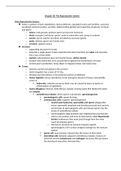Class notes
Chapter notes
Lecture notes study book Principles of Anatomy and Physiology of Gerard J. Tortora, Brendan Burkett, Bryan H. Derrickson, Julie Cooke, Danielle Dye, Tara Diversi, Mark McKean, Rebecca Mellifont, Latika Samalia, Greg - ISBN: 9780730314622 (Notes)
[Show more]



